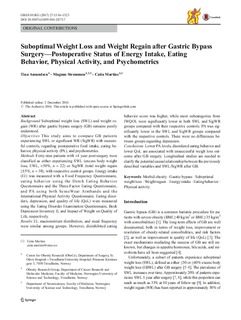| dc.contributor.author | Amundsen, Tina | |
| dc.contributor.author | Strømmen, Magnus | |
| dc.contributor.author | Martins, Catia | |
| dc.date.accessioned | 2018-02-01T09:26:57Z | |
| dc.date.available | 2018-02-01T09:26:57Z | |
| dc.date.created | 2017-01-03T13:41:27Z | |
| dc.date.issued | 2017 | |
| dc.identifier.citation | Obesity Surgery. 2017, 27 (5), 1316-1323. | nb_NO |
| dc.identifier.issn | 0960-8923 | |
| dc.identifier.uri | http://hdl.handle.net/11250/2481141 | |
| dc.description.abstract | BACKGROUND: Suboptimal weight loss (SWL) and weight regain (WR) after gastric bypass surgery (GB) remains poorly understood. OBJECTIVES: This study aims to compare GB patients experiencing SWL or significant WR (SigWR) with successful controls, regarding postoperative food intake, eating behavior, physical activity (PA), and psychometrics. METHODS: Forty-nine patients with >1 year post-surgery were classified as either experiencing SWL (excess body weight loss, EWL, <50%, n = 22) or SigWR (total weight regain ≥15%, n = 38), with respective control groups. Energy intake (EI) was measured with a Food Frequency Questionnaire, eating behavior using the Dutch Eating Behavior Questionnaire and the Three-Factor Eating Questionnaire, and PA using both SenseWear Armbands and the International Physical Activity Questionnaire. Eating disorders, depression, and quality of life (QoL) were measured using the Eating Disorder Examination Questionnaire, Beck Depression Inventory II, and Impact of Weight on Quality of Life, respectively. RESULTS: EI, macronutrient distribution, and meal frequency were similar among groups. However, disinhibited eating behavior score was higher, while most subcategories from IWQOL were significantly lower in both SWL and SigWR groups compared with their respective controls. PA was significantly lower in the SWL and SigWR groups compared with the respective controls. There were no differences between groups regarding depression. CONCLUSIONS: Lower PA levels, disordered eating behavior and lower QoL are associated with unsuccessful weigh loss outcome after GB surgery. Longitudinal studies are needed to clarify the potential causal relationship between the previously described variables and SWL/SigWR after GB. | nb_NO |
| dc.language.iso | eng | nb_NO |
| dc.publisher | Springer | nb_NO |
| dc.rights | Navngivelse 4.0 Internasjonal | * |
| dc.rights.uri | http://creativecommons.org/licenses/by/4.0/deed.no | * |
| dc.title | Suboptimal Weight Loss and Weight Regain after Gastric Bypass Surgery - Postoperative Status of Energy Intake, Eating Behavior, Physical Activity, and Psychometrics | nb_NO |
| dc.type | Journal article | nb_NO |
| dc.type | Peer reviewed | nb_NO |
| dc.description.version | publishedVersion | nb_NO |
| dc.source.pagenumber | 1316-1323 | nb_NO |
| dc.source.volume | 27 | nb_NO |
| dc.source.journal | Obesity Surgery | nb_NO |
| dc.source.issue | 5 | nb_NO |
| dc.identifier.doi | 10.1007/s11695-016-2475-7 | |
| dc.identifier.cristin | 1419981 | |
| dc.description.localcode | © The Author(s) 2016 Open Access This article is distributed under the terms of the Creative Commons Attribution 4.0 International License (http://creativecommons.org/licenses/by/4.0/), which permits unrestricted use, distribution, and reproduction in any medium, provided you give appropriate credit to the original author(s) and the source, provide a link to the Creative Commons license, and indicate if changes were made.This article is published with open access at Springerlink.com | nb_NO |
| cristin.unitcode | 194,65,30,0 | |
| cristin.unitcode | 194,65,15,0 | |
| cristin.unitname | Institutt for nevromedisin og bevegelsesvitenskap | |
| cristin.unitname | Institutt for klinisk og molekylær medisin | |
| cristin.ispublished | true | |
| cristin.fulltext | original | |
| cristin.qualitycode | 1 | |

